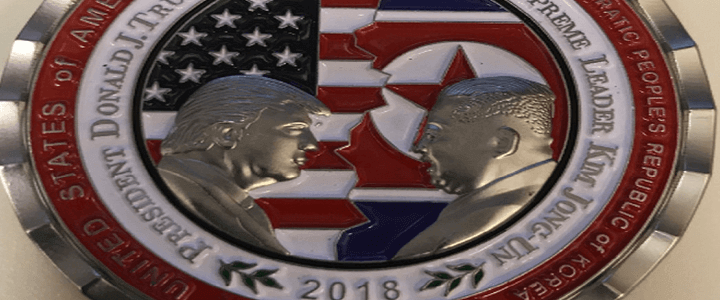There are some things you just don’t do. You don’t talk about the fact that your pitcher has a no-hitter going when he has a no-hitter going. You don’t schedule your surgery for Friday the 13th. You don’t talk about Fight Club. And you don’t make a challenge coin to commemorate an event between two notoriously fickle world leaders before it’s happened.
Over the weekend, we learned that the White House Military Office had minted a coin for the upcoming summit between President Donald Trump and North Korean Chairman of the State Affairs Committee Kim Jong-un, who also carries the title of “Dear Respected Comrade.” They may have jumped the gun.
The coin, celebrating a military tradition of uncertain origin but which dates at least to the coins given to member of the 10th Special Forces Group (which was actually the first SF group created), features profiles of Trump and Kim, who the coin erroneously identifies as “Supreme Leader,” a title he actually doesn’t hold. That title is reserved for Iran’s Ayatollah Khamenei.
But errors aside,if you’re superstitious, you might blame the coin’s premature minting for Trump’s sudden caution Tuesday afternoon.
“The big one.”
Republic of Korea President Jae Moon-in was Trump’s guest at the White House Tuesday. Moon came to town to work with Trump and his team on details for the upcoming summit with Kim, scheduled — or should I say tentatively scheduled — for June 12 in Singapore. In a joint press availability, Trump threw a pitcher of cold water on the prospects for the summit even happening.
Trump began his remarks by saying that as important as the trade agreement the two leaders were scheduled to discuss is, the unfolding situation with the DPRK was “the big one.” But within seconds of beginning to speak, the president cast doubt on the prospects for the summit.
“See what happens, whether or not it happens,” the president remarked without being asked. “If it does, that will be great. It will be a great thing for North Korea. And if it doesn’t, that’s okay too. Whatever it is, it is,” he said. But despite the foreshadowing, Trump tried to remain positive and on-message. He described the discussions with Kim’s government as “a relationship that seems to be working.
Despite Trump’s unprompted pessimism, Moon remained upbeat, continuing his prior habit of praising Trump’s leadership. “Thanks to your vision of achieving peace through strength, as well as your strong leadership, we’re looking forward to the first-ever U.S.-North Korea summit,” Moon said in his opening remarks. “And we find ourselves standing one step closer to the dream of achieving complete denuclearization on the Korean Peninsula and world peace,” he said.
While it is fairly clear that Moon, who also wants the trade deal that was on the table today, is playing to Trump’s weakness with his flattery, there are still too many who go the complete opposite direction.
Reluctance to grant Trump any credit
We can debate the extent to which Trump’s “maximum pressure” policy brought North Korea to the table, but too many still insist he had nothing to do with it at all. I even argued with a college friend who said this week that the only reason Kim is at the table is that “North Korea’s entire nuclear program collapsed under a mountain where they were hiding it. The only thing Trump has to do with it is coincidence.” Talking to some other national security writers, I was stunned to learn that he is not alone in his belief.
Last month, Chinese geologists concluded that Mount Mantap, under which the North Koreans have detonated all their nuclear tests, had collapsed. While this may be the case, Korea observers such as the intrepid crew at 38North.org have concluded that portions of the Punggye-ri test site remain useful.
Regardless of the the fate of the mountain, there is absolutely no evidence that the entire site was rendered useless. There is even less evidence for the accusation the North Koreans would be stupid enough to store their warheads inside the same mountain where they conduct their tests.
Dr. Jeffrey Lewis runs the East Asia Nonproliferation Program at the Middlebury Institute of International Studies at Monterey (yes… a small liberal arts college from Vermont has a graduate school in California). Lewis and I disagree on the effectiveness of ballistic missile defense systems, but I cannot deny his expertise when it comes to the North Korean nuclear program. He is anything but a “Trumpster.”
I asked him about the theory that the entire DPRK nuclear program was forever lost under Mount Mantap. His response was as blunt as I would have expected. “That’s complete nonsense,” he said by email. “The cavity created by the most recent explosion collapsed. But there is no reason to think the tunnels at the site [are] unusable or that any nuclear weapons were stored there.”
We can debate the extent of North Korean sincerity. We can debate the extent to which Trump’s actions have affected the process, or the wisdom of striking a challenge coin prematurely. We can debate just how likely it is that we actually see a Trump-Kim summit in June.
But please, can we stop with the silly conspiracy theories?




